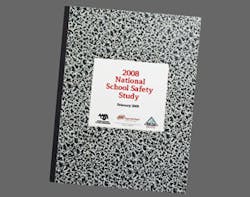Research finds mixed picture for school security
A new research report available from the American Association of School Administrators looks at perceptions of school security and actual school security in practice, and the survey finds both good trends as well as security challenges. (Download the PDF of the school security report from the AASA.)
Among the major findings of the survey, which was jointly done with the AASA, security company Ingersoll Rand Security Technologies and security consulting firm RETA Security, is that school security budgets place administrators in a challenging position. Approximately 80 percent of the school superintendents and administrators surveyed said that their funding level was “stretched†or “inadequate.â€
Budget difficulties are linked with other challenges; notably, only 37 percent of the respondents said their security program had not been reviewed by an outside group within the past year (the survey didn’t delineate between a review by a trained, professional security consultant and the types of reviews provided by local police forces). The survey also found a lack of emergency notification systems; less than 50 percent fully agreed with the statement that they “possess and make parents aware of systems that will be used to communicate with parents in the event of an emergency.â€
But even low-cost security and safety measures weren’t always being implemented. Slightly less than 70 percent said that evacuation maps were posted in all classrooms, office, gathering areas and restrooms. Most schools also couldn’t positively affirm that they had marked or numbered doorways into the school for the purpose of orienting first responders. Almost 11 percent said they didn’t have a functioning safety committee, and only 47 percent could fully agree that they had a safety committee.
Schools and access control
Access control had its ups and downs in the report. Fifty percent of the schools locked all exterior doors during session, implementing a “closed campus†policy. Another 46 percent chose to lock some but not others during the day while classes were in session. At the same time, over a third of those surveyed said they lock and monitor their public entrances, requiring visitors to “buzz in†before being allowed to enter the facility. And almost 80 percent said they were effective at requiring visitors to sign in for a badge when visiting, with a fair percentage using software systems to track this. Only a very small percentage (less than 4 percent) didn’t require visitors to sign in at all.
While there did seem to be positive trends in monitoring and locking of doors and in the implementation of visitor registration, one-third also reported that exterior doors are occasionally or often propped open – a finding that might defeat the point of visitor badging and closed campus “buzzing in†requirements.
Almost 50 percent of the school respondents said they were either not using staff or student badges or not enforcing staff and student badge policies. Of the other half which said they do use badges, the badges were mainly provided to staff. Only 16 percent of all respondents said they are having both students and the staff use badges.
Surveillance is strong, but not intrusion detection
Video surveillance on buses was one strong suit in the survey, with 60 percent using and recording surveillance video on their buses. Cameras were also quite common on school property, with only 23 percent saying that they don’t use or record from video surveillance cameras. Almost 18 percent of the administrators said they had 64 or more interior cameras in their schools, and the most common method of recording was to a DVR.
The outlook wasn’t nearly so good for the usage of intrusion detection alarm systems. Some 42 percent said that the building either didn’t have an alarm system (38.7 percent) or that the alarm system wasn’t functioning (3.1 percent). On top of that, 35 percent said that common school areas like classrooms, offices and gathering areas did not have any sort of panic alarms.
School incident and crisis preparedness
Overall, though, the survey found that schools were doing a fairly good job at implementing security awareness and practices. Some of the highlights: almost half do period contraband searches. Almost all schools said they do some sort of lockdown drill practice regularly, and almost all said that staff receive continuous training on security and safety issues.
Another bright spot was crisis readiness. Roughly 81 percent of respondents nationally have written crisis procedures for security emergencies and environmental emergencies (e.g., fire, storms) and over 71 percent have crisis procedures also written for medical emergencies, with 50 percent having details that identify staff members ready to provide CPR, first aid and AED efforts.
More information:
AASA 2008 National School Safety Study (PDF document)
Ingersoll Rand online school security self-audit tool
